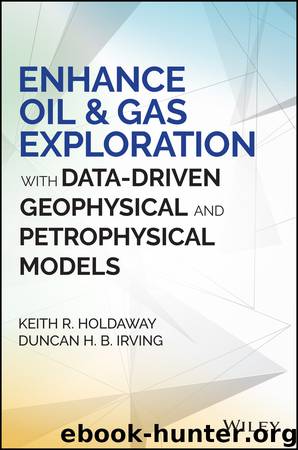Enhance Oil and Gas Exploration with Data-Driven Geophysical and Petrophysical Models by Keith R. Holdaway Duncan H. B. Irving & Duncan H. B. Irving

Author:Keith R. Holdaway,Duncan H. B. Irving & Duncan H. B. Irving [Неизв.]
Language: eng
Format: epub
ISBN: 9781119302582
Publisher: John Wiley & Sons, Inc.
Published: 2017-10-09T19:11:03+00:00
WAVELET ANALYSIS
Wavelets provide an active device to understand and analyze time series data. Wavelet analysis has critical applications in nonparametric modeling, pattern recognition, and seismic feature identification. The wavelets enable geophysicists to localize knowledge across an array of scales and mathematical loci. Traditionally, geophysicists focus on the amplitude differences and variations in the velocity field that are reflected in time shifts across seismic 3D data cubes in a temporal dimension. Any amplitude dimming or brightening is invariably correlated with an increase in water and gas saturation respectively. Additionally, a positive time shift reflects a decrease in pressure and, conversely, a negative time shift infers an increase in pressure. Geophysicists play with wavelets, studying their fundamental mathematical components, to better appreciate the time series seismic data owing to the versatility of wavelet analysis. Wavelets offer the potential to improve nonparametric models, identify hidden patterns, determine seismic features, and improve the resolution of seismic profiles for better stratigraphic and structural understanding. The petrophysicist has access to localized data of high resolution from cores and well logs; geophysicists use wavelet analysis to provide a detailed narrative of the seismic data that substantially restricts the knowledge across an array of scales and spatial locations. Also, the scales and spatial locations can be calculated efficiently via an innate and well‐designed mathematical theory.
As a mathematical approach, wavelet analysis embodies both data and their functional relationships. The functions consist of mathematical properties. We can detect different scales and resolutions. Through wavelet analysis, we can accommodate spikes and discontinuities more efficiently than implementing a traditional fast Fourier transform (FFT). Traditional applications of wavelet analysis have focused on image compression. Fourier explains that a signal is a synthesis of sinusoidal waves of varying amplitudes, frequencies, and phases. The following example illustrates a seismic wavelet analysis applied to a Fourier transform of the trace data from the time‐offset (temporal frequency of a wave) domain to the frequency‐wavenumber (spatial frequency of a wave) domain. The spectrum is expressed as an amplitude value for each of the wavenumbers. Figure 5.5 is an illustration of the line plot for the data under study. Wavelets can be computed proficiently and provide an intuitive and sophisticated mathematical theory to escort the geophysicist through the maze of subtle signatures. The seismic data used in this study represents a mapping of a stratigraphic trap in a carbonate reservoir in the Middle‐East. Widess (1973) developed a wedge model that illustrated maximum constructive interference occurs when there is equality between the wedge and tuning thickness. Subsequently, Laughlin et al. (2002) demonstrated that the channels at a greater depth are defined by stronger amplitudes at the lower frequencies, simultaneously showing that the amplitudes of the flanks at shallower depths are stronger at higher frequencies.
Figure 5.5 Line plot showing seismic trace data post F‐K transform
Download
This site does not store any files on its server. We only index and link to content provided by other sites. Please contact the content providers to delete copyright contents if any and email us, we'll remove relevant links or contents immediately.
| Automotive | Engineering |
| Transportation |
Whiskies Galore by Ian Buxton(41524)
Introduction to Aircraft Design (Cambridge Aerospace Series) by John P. Fielding(32883)
Small Unmanned Fixed-wing Aircraft Design by Andrew J. Keane Andras Sobester James P. Scanlan & András Sóbester & James P. Scanlan(32569)
Craft Beer for the Homebrewer by Michael Agnew(17927)
Turbulence by E. J. Noyes(7690)
The Complete Stick Figure Physics Tutorials by Allen Sarah(7135)
Kaplan MCAT General Chemistry Review by Kaplan(6589)
The Thirst by Nesbo Jo(6432)
Bad Blood by John Carreyrou(6271)
Modelling of Convective Heat and Mass Transfer in Rotating Flows by Igor V. Shevchuk(6219)
Learning SQL by Alan Beaulieu(6029)
Weapons of Math Destruction by Cathy O'Neil(5822)
Man-made Catastrophes and Risk Information Concealment by Dmitry Chernov & Didier Sornette(5641)
Digital Minimalism by Cal Newport;(5388)
Life 3.0: Being Human in the Age of Artificial Intelligence by Tegmark Max(5182)
iGen by Jean M. Twenge(5155)
Secrets of Antigravity Propulsion: Tesla, UFOs, and Classified Aerospace Technology by Ph.D. Paul A. Laviolette(4974)
Design of Trajectory Optimization Approach for Space Maneuver Vehicle Skip Entry Problems by Runqi Chai & Al Savvaris & Antonios Tsourdos & Senchun Chai(4837)
Electronic Devices & Circuits by Jacob Millman & Christos C. Halkias(4739)
